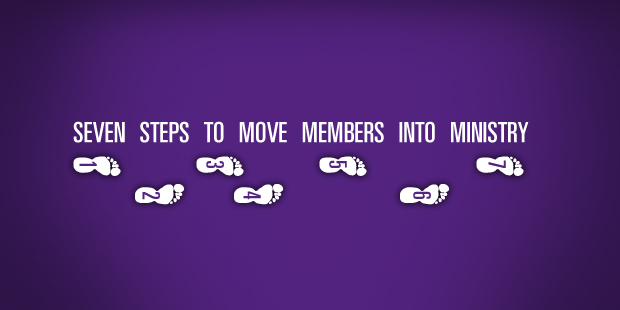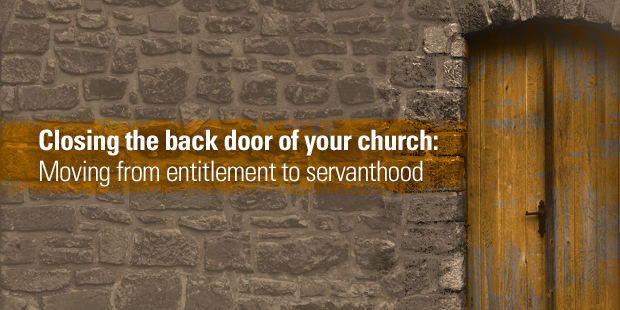As church leaders, we know people won’t become disciples by sitting through services or just studying the Bible in classrooms. Jesus showed us that mission is the context for making disciples who can make disciples. Every church leader faces huge barriers like busyness and fear, keeping our people away from mission.
At Granger Community Church, we’ve seen thousands move out on mission, culminating in redemptive movements locally and globally from Monroe Circle Community Center, a hub for neighborhood renewal in the inner city, to a movement of more than 1.000 reproducing churches in India that includes more than 120,000 people. We’ve realized that people need a series of steps into deeper engagement with mission.
But that revelation didn’t come overnight nor did it come easy. In 2009, we began to notice that despite the innovative nature of most of our access-oriented events and the relatively large turnout and momentum they first generated, interest and momentum were definitely waning. I liken what was happening to swimming. Any competitive swimmer will tell you that swimming is about technique and consistency. It’s about working with the water and minimizing your effort for maximum effect to get where you are going as fast as you can. It’s about cutting through the water like a blade, not pummeling it into submission. The harder you fight when you swim, the slower you go and the more exhausted you get.
Contrast that with surfing, which requires a different sort of talent. A surfer needs good technique, but radically different from swimming. You can’t just keep doing the same thing with good technique over time to achieve the result. A surfer has to anticipate swells and troughs, watch for turns in the current, be sensitive to what’s beneath. A surfer needs an impeccable sense of timing.
Every month, we had the predictable routine of Second Saturday (all-church community service event). It became too predictable. We were still doing it with excellence. We had made each event operate with a level of efficiency and technique that would make the most meticulous process-engineer beam with pride.
But somewhere along the way, it had lapsed into swimming, and we realized that swimming wasn’t helping us. Sure, our attendance at access events like Second Saturday didn’t plummet, but one Saturday after evaluating the event, I (Rob) remarked, “We’ve effectively achieved ‘wallpaper’ status with Second Saturday. It’s there. It looks nice. It accomplishes its job. But no one notices it anymore. We need to change or improve it.” In short, we realized that we needed to start surfing.
With some difficulty, we began modifying our monthly access rhythm. We needed greater variety that leveraged people’s desires to have both increasing commitment but also periods of rest. We also realized this required a level of interest that would undermine the yawn-response and easy predictability to which we had all grown accustomed.
In short, we started to create some waves of activity that would allow people to surf rather than swim. We call it the Wave. Here’s what our rhythm is now being molded to resemble as we focus on creating a spectrum of involvement:
Large Scale Quarterly Events (SWARM) Every year at our annual Food Drop, more than 2,000 volunteers and just under 200 volunteer leaders show up to distribute between 130,000 to 250,000 pounds of food and personal care items into the communities surrounding Granger. These volunteers regularly brave blizzards, sub-zero temperatures, unplowed neighborhoods and a host of other obstacles to participate in the day’s activities. We consistently hear that it is one of the high points for many people who attend our church in their annual serve cycle. In fact, many people who normally take vacations at this time of year (or evacuate to warmer climates for longer periods of time altogether) have over time, rearranged schedules to avoid missing our Drop.
Because of this, we began to design large-scale, “all hands on deck” sorts of events that are similar in size and scope (though not in cost) to our Food Drop, giving people a predictable rhythm of mass participation and encouraging a completely anonymous, no-strings-attached feel that is typical of our standard access ministries, but with the heightened sense of buzz that accompanies having 2,000 people show up at a given event to impact the community. These events are called SWARM events, and occur approximately each quarter.
Another example of a SWARM event was our Supply Drop. Starting in 2012, we began to think through how we might be able to target large-scale SWARM events around the key domains of society. We began grouping ideas around domains that seemed to be on opposite ends of one spectrum or another. Examples included the potential of events that targeted both government and religion since our “Separation of Church and State” ideals often see those two domains as impossible to engage together. Or perhaps an event that seeks to serve business and art, two seemingly opposite concepts since one operates on the utility of economy and the other the aesthetic of beauty.
We decided first to try to put our attention on healthcare and education, since they’re cultural hot buttons. We refined that focus by singling out Medicare-Medicaid recipient nursing homes, which usually cater to the elderly and the forgotten. We also focused on Title One schools in our area, which identify low-income children and families.
We simply called our first event “Supply Drop.” More than 2,000 members from our Granger and Elkhart, Ind., campuses joined together to create care packages specially designed for Title One schoolteachers and Medicare-Medicaid nursing home residents. These packages reached more than 50 schools and facilities throughout our community.
As a follow-up to the event, one Granger member said, “The Drop was a great opportunity to serve with my whole family. I got to teach one of my sons the life skill of talking with someone that’s quite shy, which was a bonus opportunity for me to pour into my children.”
ONE Day Experiences are built around longer-scale commitment than what our original Second Saturdays required, but still require no more than a single day from a given individual or family’s schedule. Also similar to Second Saturday, ONE Day Experiences provide transportation and limited time/scope opportunities to meaningfully serve (in approximately two-hour chunks) throughout the community. Unlike original Second Saturday opportunities, we charge a small fee to cover the cost of the transportation and lunch. We require pre-registration to participate.
Promotion for ONE Day Experiences (the following month after a SWARM event) occurs on the back end of these types of experiences, giving people a chance to understand better what their next step may be as they move from pure access across the spectrum toward ongoing teams and leadership.
MOVE Weekends MOVE is a concept that was actually pioneered by our student ministries, and operates as a weekend-long local mission trip where people are permitted to return to their homes at the end of every night and sleep in their own beds. During a MOVE weekend, the commitment is considerably higher (MOVE experiences start on Friday night and run through Sunday afternoon and include worship, prayer and devotional elements in addition to service). We also charge for participation and require pre-registration, and have more time to discuss movement into the ranks of Ongoing Teams than at SWARM events and One Days.
Rest It’s helpful to program in rest simply because people will take it anyway. Programmed rest gives our leadership teams the opportunity to take a break, and it allows time for promotion and communication in the process of ramping up for the next SWARM event.
This new wave still honors the desire for some predictability, but also provides enough variety and deepening opportunities for involvement that people can more easily and fluidly cross the Spectrum of Involvement to deepening levels of commitment and service. It also allows people to more easily customize their journey and keeps all of us from settling into a nice, sleepy rhythm.
Ongoing Teams and Leadership continue to operate as they always do. But the greater diversity of our experiences and the progressively increasing and more moderated type of opportunities offered draws people closer and more intentionally toward them than our previous Second Saturday experience did. The hope is that we see more and more of Granger’s members taking steps across the access and project lines to greater exposure and eventual membership into the team and leader ranks as their stage of life and commitment allow. As with all things at our church, even the above model will be continually subject to evaluation and change to ensure that it stays innovative and is not permitted
We’re not suggesting that you or your church should carbon copy our Second Saturday, Food Drop, Wave or other processes just because they have worked for us. You’re welcome to implement and adapt everything we have, but that’s not the point of any of the above. Rather, the point is to get you thinking about helping your people take steps toward deeper and deeper levels of personal commitment and experience in the mission of God in the world.
We are firm believers that having a spectrum of involvement is a good idea and a fantastic place to start, but the individual manifestations of what your church’s spectrum might look like may be very different from those of our church’s. That’s okay. That’s fantastic, actually. We’ll bet that you’ll discover things that we haven’t, and we’ll take great joy in learning from and alongside you as you do so.

Tags: Discipleship, Jack Magruder, Mission, Rob Wegner, Serve, Vision
|
What is MyVisionRoom? > | Back to Process >
































